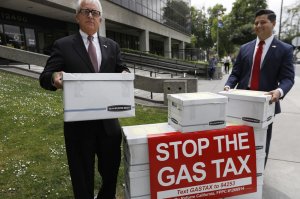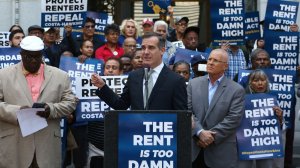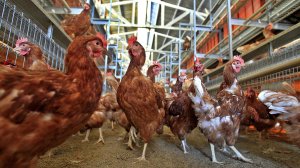With early voting underway and mail-in ballots having long since been delivered to California homes, political campaigns for the Nov. 6 election have kicked into high gear.
Taking up plenty of mailbox space – and television and radio airtime – these days: ads about ballot measures that will affect the entire state.
Voters get to decide on 11 initiatives (a 12th proposition, which would have asked Californians whether or not they want to split the state into three, was blocked by the California Supreme Court in July).
Here’s a breakdown of what approving or rejecting each ballot measure means, plus what supporters and critics are saying.
Proposition 1: Bonds for housing programs
Voting “yes” means letting the state borrow and pay with interest $4 billion to fund various housing assistance programs.
One billion dollars will be spent on home loans for veterans, who’ll make monthly payments to cover the amount owed. This will have no direct cost to taxpayers.
The rest will go to building or renovating affordable units for low-income households, constructing housing for farmworkers, and distributing loans to low- and moderate-income homebuyers. This will cost taxpayers about $170 million every year for 35 years, or about one-tenth of 1 percent of California’s annual budget.
Voting “no” means blocking the state from borrowing $4 billion to fund these housing programs.
Supporters – The Los Angeles Times editorial board says the initiative won’t fix the housing crisis but calls it a “necessary step” to tackle one of California’s biggest problems.
The editorial boards for the San Francisco Chronicle and The Sacramento Bee support Prop 1 as well. The campaign pushing for the initiative lists endorsements from the Habitat for Humanity California, the Vietnam Veterans of America California State Council, the California Sheriff’s Association, the California Partnership to End Domestic Violence, among other groups.
Opponents – The San Diego Union-Tribune editorial board argues the measure will help “relatively few lucky families.” The board sides with tax-averse lobbyists who say certain policies – including some environmental regulations and rules requiring developers to pay “prevailing wages” to workers on low-income housing projects, for example – are a disincentive to construction and should be changed instead. The editorial board for the Southern California News Group, which runs the L.A. Daily News, the O.C. Register, the San Bernardino Sun and other community newspapers, makes a similar argument.
Proposition 2: Using mental health funding for housing
Voting “yes” means letting the state use existing mental health funds to house homeless people with mental illness through a program called No Place Like Home.
This would be funded through a $2 billion bond that in turn would be paid back with tax revenue generated from a 1 percent tax on California millionaires, Proposition 63, which voters approved back in 2004 to pay for mental health services.
In 2016, the state Legislature approved the No Place Like Home Act, which would have allowed Prop 63 funds to pay for the $2 billion bond, but a still undecided lawsuit has held up the funding. The lawsuit argues Prop 63 money should go to treatment – not housing.
Voting “no” means blocking the state from using the Prop 63 funds to pay for a bond that would fund housing mentally ill people who are homeless.
Supporters – The Sacramento Bee describes approving Prop 2 as a “no-brainer,” arguing treatment “can only help so much when people are forced to return to the trauma of living on the streets.”
The campaign for the measure also lists support from the California Police Chiefs Association, the National Alliance of Mental Illness California, the Mental Health America of California, among other groups.
The top contributors for the Props 1 and 2 campaigns include labor union groups, a committee of real estate companies and a nonprofit founded by Facebook’s Mark Zuckerberg and Priscilla Chan.
Both the California Democratic Party and GOP support this measure.
Opponents – The official California voter guide lists the Contra Costa chapter of NAMI on the opposing side.
While most major newspapers in the state endorse Prop 2, including the L.A. Times and San Diego-Union Tribune, the editorial board for the Southern California News Group says the payments on the $2 billion bond would constitute a “squandering” of money for mental health care.
“In a high-tax state like California, it shouldn’t be hard for the state and local governments to come up with $2 billion in direct funding over 30 years for supportive housing so long as mental health and homeless services are properly prioritized,” the paper said.
Proposition 3: Bonds for water projects

Voting “yes” means authorizing $8.9 billion in state debt for programs intended to improve water infrastructure (canals, dams, storage), water safety, wildlife habitats and other water-related issues.
This will cost taxpayers about $430 million annually over four decades.
Voting “no” means keeping the state from borrowing $8.9 billion for these projects.
Supporters – Land O’ Lakes, Dairy Farmers of America and American Pistachio Growers are among the top donors for the Prop 3 campaign. John Cox, the Republican candidate for governor, told CALmatters the measure will provide “the opportunity to build dramatically more storage and provide clean water.”
Unlike most water bonds, the measure got on the ballot not through the Legislature but by gathered signatures.
The editorial boards for The Fresno Bee and The Press Democrat of Santa Rosa endorse the initiative.
Opponents – Sierra Club California calls Prop 3 an example of “pay-to-play” policy-making. The conservation group says there will be little oversight of the projects the measure will fund, and that special interests “will ultimately profit from the bond at the taxpayers’ expense.”
The editorial boards for the L.A. Times, the San Diego-Union Tribune and the Desert Sun oppose Prop 3, with the Times saying it largely benefits Central Valley agriculture at a cost to all Californians.
Proposition 4: Bonds for children’s hospitals
Voting “yes” means allowing the state to borrow and pay with interest $1.5 billion to fund building, expanding, renovating and upgrading equipment for a group of children’s hospitals. This will cost taxpayers about $80 million every year over 35 years.
Voting “no” means preventing the state from borrowing money to fund the facilities.
Supporters – The California Children’s Hospital Association, which includes Children’s Hospital Los Angeles, Children’s Hospital Orange County and six other children’s health facilities, sponsors Prop 4. The group says the measure will help the hospitals ensure more kids get access to necessary care.
L.A. Mayor Garcetti calls the initiative “one of the best investments we can make.” The L.A. Times and the San Diego-Union Tribune editorial boards also support the measure.
Opponents – The League of Women Voters of California contends state funds shouldn’t go toward privately owned facilities. The California Republican Party and the editorial board for the Southern California News Group also oppose the measure.
Proposition 5: New property tax break for seniors
Voting “yes” means letting all homeowners over 55 (or those who meet other conditions, such as having a severe disability or being the affected by a natural disaster) pay lower property tax rates when they sell a home and buy a new one — regardless of their new home’s market value or where they relocate in the state.
The measure would essentially let beneficiaries take their property tax rates from one home to another, meaning that those who have lived in their homes for many years and thus have very low property tax rates – thanks to California’s 1978 Proposition 13 – get to maintain those low rates.
Under the current system, many homeowners over 55 are eligible for a property tax savings when they move to a new home of equal or lesser and within the same county as their previous home. They can only benefit from this with one move, however.
Property tax revenues that specifically go to schools and local municipalities will be reduced by about $1 billion a year if the measure is passed, according to a state analysis.
Voting “no” means the current property tax system will remain the same.
Supporters –The California Association of Realtors developed the initiative and gathered signatures to place it on the ballot. The San Diego Union-Tribune concedes real estate agents came up with Prop 5 to make profit, but says “it’s actually a smart idea” that will free up property, which can help improve California’s housing market.
Opponents – The Service Employees International Union’s California chapter calls Prop 5 “a boon to the real estate industry that comes at the cost of massive cuts to schools.” The California Teachers Association also opposes the measure.
The editorial boards for the L.A. Times, the San Francisco Chronicle and the Sacramento Bee disapprove of Prop 5 as well.
Proposition 6: Repealing the gas tax

Voting “yes” means the repeal of a 12 cent-per-gallon sales tax increase on gasoline that funds a massive $130 billion transportation package enacted by lawmakers in 2017 to repair highways and roads and fund mass transit.
The proposition would also nix a 4 percent tax hike on diesel, the new annual “transportation improvement fee” ($25 to $175) added to drivers’ registration payments, as well as the $100 fee charged yearly to owners of zero-emission vehicles.
Voting “no” means keeping the gas tax to fund repair and maintenance of highways, bridges and other transportation projects.
Supporters – Cox and GOP leaders in Congress spent $1.7 million to place the repeal on the ballot. The Southern California News Group editorial board endorses Prop 6. Cox, who is chairman of the Proposition 6 committee, is supporting the measure as part of his campaign for governor.
Opponents – Democrats, along with labor unions and construction companies that stand to benefit from transportation projects, have raised millions of dollars to defeat the repeal. The California Chamber of Commerce and the League of California Cities also oppose Prop 6.
“Sure, you might save $1.50 every time you fill up your sedan,” the L.A. Times editorial board argues. “But you’ll spend a lot more repairing tires, alignment, shocks and other parts caused by driving on potholed and damaged roads.” The board calls it “a ballot measure only a pothole could love.”
The San Diego-Union Tribune and the Sacramento Bee editorial boards also oppose Prop 6.
Proposition 7: Making Daylight Saving Time permanent, with a caveat
Voting “yes” clears a path for year-round Daylight Saving Time in California—meaning no more falling backwards and brighter evenings during wintertime. If passed by voters, it will still need a two-thirds vote in the state Legislature and approval from the federal government.

Earlier this year, Florida’s lawmakers agreed to make Daylight Saving Time permanent in their state. But with less than three weeks until Nov. 4, the day DST ends, Congress has yet to approve the change.
The L.A. Times says even if Californians OK Prop 7, year-round Daylight Saving Time will likely stall in the Capitol.
Voting “no” means California will keep springing forward and falling backward, along with the majority of the country.
Supporters – Having more light in the evening all year joins Prop 2 as the only statewide initiatives endorsed by California Democrats and Republicans alike.
Opponents – The editorial board for the Sacramento Bee says the state “doesn’t have time” to waste deliberating on a decision that would still require permission from Washington, not to mention the hassle and costs to businesses that operate in other states. The Mercury News and the San Diego-Union Tribune agree.
Proposition 8: Capping dialysis clinics’ revenues
The state estimates the nearly 600 dialysis clinics in California make about $3 billion a year offering critical treatment to patients whose kidneys no longer function, with two private, for-profit companies operating a majority of those clinics.
Voting “yes” means limiting dialysis clinic companies’ revenues, requiring them to refund patients or insurers any revenue that exceeds 115 percent of what it costs to provide drugs and medical supplies, maintain facilities and train and pay staff wages and benefits.
Voting “no” means opposing limits to dialysis clinics’ revenues.
Supporters – One health care workers union has spent about $20 million to push for the ballot measure, arguing that it will force companies to hire more staff and upgrade equipments and facilities. The state Democratic Party supports the measure.
Opponents – With dialysis providers paying more than $70 million to defeat the initiative, campaigns for and against Prop 8 have surpassed the gas tax repeal and rent control as the costliest ballot measure in the California midterm, the Associated Press reports.
The National Kidney Foundation says passing Prop 8 will prompt dialysis providers to close clinics. Major editorial boards, from the L.A. Times to the Sacramento Bee, contend the labor union behind the measure is using it as a tactic to organize workers at the expense of patient safety. The California Republican Party is also opposed.
Proposition 10: Allowing cities to expand rent control
Current state law, the Costa-Hawkins Rental Housing Act, bans cities and counties from imposing new rental price restrictions on housing built after 1995 and on single-family homes. If a tenant moves out, landlords can decide how much to charge the new renter without restrictions.
Currently, 15 cities in California – including Los Angeles, Santa Monica and West Hollywood – have some form of rent control that complies with Costa-Hawkins.

Voting “yes” means repealing this state law and enabling hundreds of local jurisdictions to decide on their own rent control policies.
Voting “no” means letting stand current rent control policies under state law.
Supporters – The AIDS Healthcare Foundation has contributed millions in support of Prop 10. The L.A. Times editorial board endorses the measure, saying each city should be able to decide how to respond to the housing crisis on its own terms. More than 9.5 million Californians spend more than 30 percent of their income on rent, the Times reported, and rents have risen dramatically in many areas of the state in recent years.
Labor groups and the state Democratic Party support Prop 10.
Opponents – Apartment property owners are funding the campaign to defeat Prop 10. The editorial board for Southern California News Group argues expanding rent control will discourage new development. The California Chamber of Commerce and the California Republican Party oppose the measure.
Many economists also argue that if landlords can’t charge at market rate, they’ll take properties off the rental market (turning them into Airbnbs or condos instead) and thus contribute to a rental housing shortage.
Proposition 11: Requiring private ambulance workers to remain on call during breaks
Voting “yes” means letting private ambulance companies to continue keeping their EMTs and paramedics on-duty during their breaks so they can respond to 911 calls.
Voting “no” means subjecting those companies to industry labor laws. Ongoing litigation signals that laws will likely require them to provide workers with uninterrupted meal breaks.
Supporters – This measure is backed by Colorado-based American Medical Response, a private ambulance company that operates in California. According to the San Diego-Union Tribune, private ambulance companies paid to gather signatures to get the measure on the ballot out of fear of a 2016 California Supreme Court ruling that found it unlawful to require private security personnel to be on-call while on break.
The L.A. Times editorial board calls the measure “sensible” for public safety, noting that it’s standard operation for police officers, firefighters and other emergency responders to remain on-duty while they take their paid breaks.
Opponents – No one, not even unions representing emergency responders, submitted an argument against the measure on the official voter guide. However, the California Democratic Party opposes Prop 11, as do several labor unions.
“This is one company looking out for their liability and imposing it on an entire industry,” said Jason Brollini, the executive director of an emergency medical workers union based in San Jose.
Proposition 12: Setting new minimum space requirements for confining farm animals
Voting “yes” means expanding the required amount of living space for farm animals from “must be able to turn around freely, lie down, stand up, and fully extend their limbs” (language from Prop 2, which was approved in 2008) to specific amounts: 43 square feet for calves raised for veal starting in 2020; 24 square feet for breeding pigs starting in 2022. For egg-laying hens, the measure would require 1 square foot of floor space starting 2020, and cage-free housing starting in 2022.
The sale of meat from farms animals that are bred in noncompliant conditions would be banned.

A state analysis say prices for eggs, pork and veal will likely rise, but since several companies have announced that they’re working on providing more space to farm animals anyway, some of these price hikes were already likely to occur.
Voting “no” means letting stand the current space requirements for farm animals, which are based on their ability to move, not square footage.
Supporters – The American Society for the Prevention of Cruelty to Animals and the Humane Society endorse Prop 12.
“The measure most likely would have little cost other than decreased tax revenue from farms and egg producers who might decide to get out of the egg or meat products business,” the Monterey Herald editorial board argues. The L.A. Times and Mercury News editorial boards also support the measure, as does the California Democratic Party.
Opponents – PETA says it doesn’t consider 1 square foot for hens “remotely humane,” and that the measure will send the wrong message. The Association of California Egg Farmers argues it will “remove consumer choice.” The state Republican Party opposes Prop 12.





















